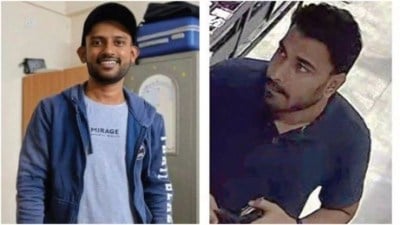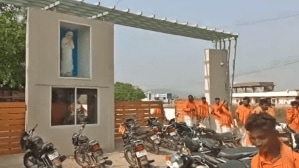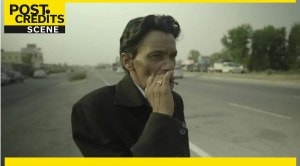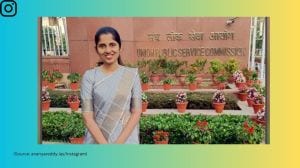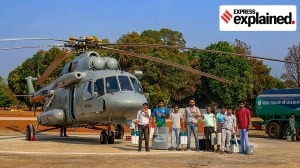- India
- International
The ‘forgotten victims’ in riot camps that aren’t
Hailing from areas not affected by violence, they are not recognised as victims. They stay rooted to camps officially closed.
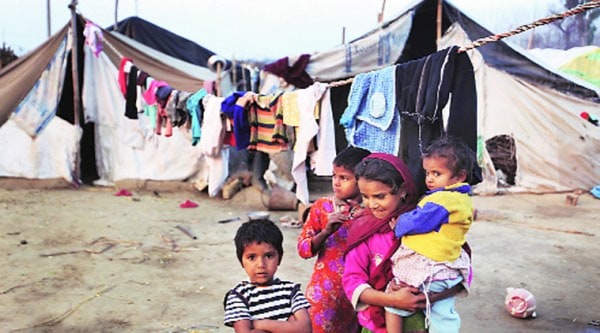 Gulafza (red scarf) with her surviving siblings, who hail from Baghpat, in the camp at Kairana in Shamli district. (Source: IE photo by Oinam Anand)
Gulafza (red scarf) with her surviving siblings, who hail from Baghpat, in the camp at Kairana in Shamli district. (Source: IE photo by Oinam Anand)
Ten-year-old Gulafza from Tilwara in Baghpat district lives inside a ragged tarpaulin tent in Kairana in Shamli, struggling to keep out the winter chill, cooking and caring for her three siblings aged nine, seven and four. Her parents, who started working at brick kilns in Jhajjar last October, travel “home” once a month to buy supplies for the children.
Gulafza, her siblings and their parents are among the hundreds who are still waiting for relief in camps set up after the Muzaffarnagar riots of 2013, camps that no longer exist on paper.
Officially, they are “squatters” either on forest land or on land “donated” by local politicians. They have not even been listed as riot-affected since they are not from the epicentre of the communal violence. They are from neighbouring villages in Baghpat, who reached the camps fearing the violence would catch up with them. They are too scared to return, even now.
“People who have left Shamli district are those who have got compensation, and they built homes elsewhere. There was no violence in our village but the elders told us to flee. Even now, seeing the way political events have been over the last year, how can I possibly return home?” says Gulafza’s father, Sarfaraz.
N P Singh, Shamli’s district magistrate, says around 600 such people were identified by a UP Forest Department survey in October 2014, although local residents say it is around 1,000-1,200. “We sent a list of around 600 people to the Baghpat DM when we were collecting data for compensation in October, and none of them was identified as a riot victim,” Singh tells The Indian Express. “The Baghpat authorities said that in some cases there was no violence in their villages; in some cases, the authorities could not even verify if they were from Baghpat. On humanitarian grounds, the administration could not turn them out forcibly, but we could not count them as riot victims either.

“The facilities made available in camps last year were discontinued, and we have been repeatedly telling them they should leave. FIRs were also registered against them by the Forest Department last year. According to Supreme Court orders, the authorities of the respective districts where these people belong have to verify their details and decide on compensation. If the Baghpat DM has not found them eligible, what can we do?”
Gulafza lives in what has come to be known as “Nahid colony”, on land “donated” by SP MLA Chaudhary Nahid Hassan who has said that it would become a full-fledged colony for riot victims who did not want to return home.
But for the 300-odd families who came here after camps such as Malakpur and Khurgaan were closed, and who were found not eligible for compensation, life has hardly changed from last year. The eight makeshift toilets are clogged, there is no water or electricity supply. People go to the surrounding forests to relieve themselves, and children go in groups after snakes were seen there. The warm clothes donated before the Lok Sabha elections are the only protection the children have, and by sunset they crowd around small fires.
Sarfaraz says no political leader or even a representative of the local MLA has come to his home after his twin babies died three months ago —- one immediately after birth, the second a month later.
Shehzad, also from Baghpat, said they were now the “forgotten victims” of the riots. “Just because no one died in Baghpat does not mean we were not scared. Why else would we leave our homes and come?” he says.
Local leaders affiliated to the BSP have provided land to a group of 50-odd families in Dabheri Khurd village. In Suneti, where a relief camp was running earlier, the pradhan, who is with the SP, has set up a colony of 65 jhuggis. Fatima from Baulwa Khedi in Baghpat, who is staying in Suneti, said returning home was not an option. “The riots happened before the Lok Sabha elections; now state elections are coming up. Who knows what can happen?” she says.
In one of the largest relief camps in Khurgan, where Youth Congress members helped provide tents, electricity supply and a water tanker last year, the 50-odd families who remain remember Rahul Gandhi’s visit before the polls. Even now, Congress flags are painted on all the poles and the water tank, but no leader has visited since the elections.
With the camp here officially closed, rations and weekly visits of medical teams too have stopped. Shabnam, from Majeedpur in Baghpat, says she lost her three-year-old daughter two months ago. “The hakeem in the village gave me some medicines, but she died. I think she had pneumonia,” Shabnam said.
There are no treatment records of her children or those of four other families who claimed the children died in the last six months. “If the administration had given us our compensation, we would have left and built new homes, and our children would have survived. Till the camp was here, my children got milk, and we were getting monthly rations. In the last three months, everything has stopped, The tehsildar comes here only to tell us to move out,” says Momeena, also from Majeedpur in Baghpat.
In Malakpur, which housed the largest relief camp in Shamli, 40 families still stay in an open field, according to Khurshid, the pradhan.
Shamli DM Singh, however, says that according to the administration’s surveys, the people in remaining camps are a “rotating group”. “Last year we conducted two surveys, in March and October. From around 600, the second survey could identify only 50-odd people who were there during the first survey in March. People who are traumatised cannot run away a year after the riots, so we found it odd.
We found many of them are girls from here who got married in Baghpat after the riots, but then returned with their families,” Singh said.
Best of Express
Buzzing Now
Apr 18: Latest News
- 01
- 02
- 03
- 04
- 05











